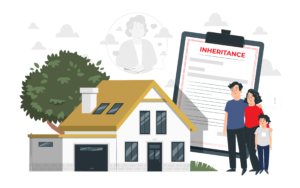How Joint Ownership Avoids Probate
- Joint Tenancy with Right of Survivorship: If you add your children as joint tenants, when you die, your share of the home automatically passes to the surviving joint owners (your children), bypassing your estate and avoiding probate on that asset.
- Tenancy in Common: If you and your children own the home as tenants in common, your share passes through your estate and is subject to probate.
Legal and Practical Risks
- Loss of Control: Once your child is on title, you cannot sell, mortgage, or otherwise deal with the property without their consent. If a dispute arises, your child could even force a sale under Ontario’s Partition Act.
- Exposure to Your Child’s Creditors: If your child faces financial trouble, divorce, or legal claims, their share of the home could be at risk from creditors or in family law proceedings.
- Family Disputes: If you have more than one child and only add one to the title, this can create conflict and potential litigation among siblings after your death.
The “Presumption of Resulting Trust”
- When you add an adult child to your home’s title without receiving payment (a gratuitous transfer), Ontario law presumes your child holds their interest in trust for you or your estate, unless you clearly intended to make a gift.
- If your intention is not well documented, other beneficiaries may challenge your child’s ownership after your death, leading to costly and stressful legal battles.
Tax Implications
- Capital Gains Tax: If your home is not your child’s principal residence, adding them to title may trigger capital gains tax on their share, both at the time of transfer and when the property is eventually sold.
- Land Transfer Tax: Depending on the circumstances, adding a child to title may also trigger land transfer tax.
Alternatives to Joint Ownership
- Inter Vivos (Living) Trusts: Transferring your home into a trust can avoid probate, but involves legal fees and ongoing tax filings. This can be in the $10,000. Range which is roughly what the Probate fees might be upon your death. So you may not be that much further ahead.
- Multiple Wills: For certain assets, using multiple wills can reduce probate fees without the risks of joint ownership. At Smartwills.ca we do prepare Secondary wills to help reduce probate fees, but often a principal residence can not be included in a secondary will. There are some special circumstances where it can be included, and we can research if this is an option for you.
- Naming Beneficiaries: For registered accounts like TFSA, RRIFs, RRSPs and insurance, naming beneficiaries ensures assets pass outside the estate and avoid probate fees. We always recommend that this step be taken and an alternate beneficiary be named to help ensure the passing of funds directly to the beneficiary without probate fees.
Key Takeaways
- Adding your children to your home’s title as joint tenants can avoid probate on the home, but exposes you to loss of control, creditor risk, family disputes, and potential tax consequences.
- The law presumes your child holds their interest in trust for you unless you clearly document an intention to gift, making proper legal documentation essential.
- Consult an experienced estate planning lawyer before taking any steps, as there may be better, safer alternatives for your situation.
“It is always best to consult a lawyer prior to making this important decision… adding your child to the title of your home could have benefits, but it could also be a risky and expensive endeavour.”
In summary, while joint ownership can help avoid probate in Ontario, it introduces significant risks and complexities. Legal advice and careful documentation are crucial before proceeding.
Check out our post on whether a Beneficiary Can Also Be a Witness to a Will
Want more information?
Are you interested in a consultation with Peter R. Welsh?
Contact me at Peter@SmartWills.ca
By telephone 416-526-3121
Register for our blog to get valuable tips and up-to-date alerts.
This material is for general information and educational purposes only. Information is based on data gathered from what we believe are reliable sources. It is not guaranteed as to accuracy, does not purport to be complete and is not intended to be used as a primary basis for investment decisions.



